The Lat pulldown is a popular compound exercise that targets and strengthens the upper back muscles, particularly the latissimus dorsi. To some extent, the exercise also engages other muscles, including the biceps, rear delt, trapezius, and shoulders.
The exercise is easy to learn and very effective at building back strength.
A lat pulldown is commonly performed on a cable machine with a wide grip.
However, you can perform lat pulldown variations. By changing your grip positions or using different types of bars (attachments), you can turn this classic exercise into a multi-faceted tool for back development.
Here are some popular Lat pulldown variations to keep your workout fresh and challenging.
- Wide-grip lat pulldown
- Close-grip lat pulldown
- Reverse-grip (supination) lat pulldown
- Neutral-grip lat pulldown
- Straight-arm lat pulldown
- Single-arm lat pulldown… Many More.
Let’s Discuss!
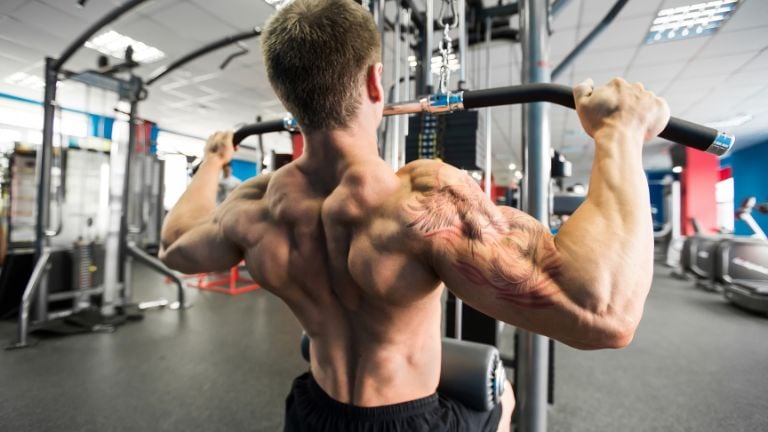
- Lat Pulldown Muscle Worked
- 1. Primary Muscles Worked During Lat Pulldown
- 2. Lat Pulldown Secondary Muscles Worked
- 3. Stabilizing Muscles Worked Pulldown
- How To Do Lat Pulldown
- Lat Pulldown Form and Tips
- Hand And Grip Position For Lat Pulldown Variations
- Lat Pulldown Grip Position
- Lat Pulldown Grip Width
- Benefits Of Lat Pulldown
- 1. Builds a Stronger Back
- 2. Improves Posture
- 3. Builds Muscle Mass
- 4. Prevents back pain
- 5. It Is a versatile exercise
- 6. Beginner-Friendly Exercise
- 7. Improves Grip Strength
- Lat Pulldown Variations
- 1. Wide Grip Lat Pulldown
- 2. Close Grip Lat Pulldown
- 3. Reverse Grip Lat Pulldown
- 4. Single-Arm Lat Pulldown
- 5. V-Bar Lat Pulldown
- 6. Behind-the-Neck Lat Pulldown
- 7 Best Lat Pulldown Variations for a Wider, Stronger Back
- FAQs
- Is lat pulldown good for the biceps?
- Is lat pulldown a compound exercise?
- Should you lean back on the lat pulldown?
- Does lat pulldown work shoulders
- Conclusion
- References
Lat Pulldown Muscle Worked
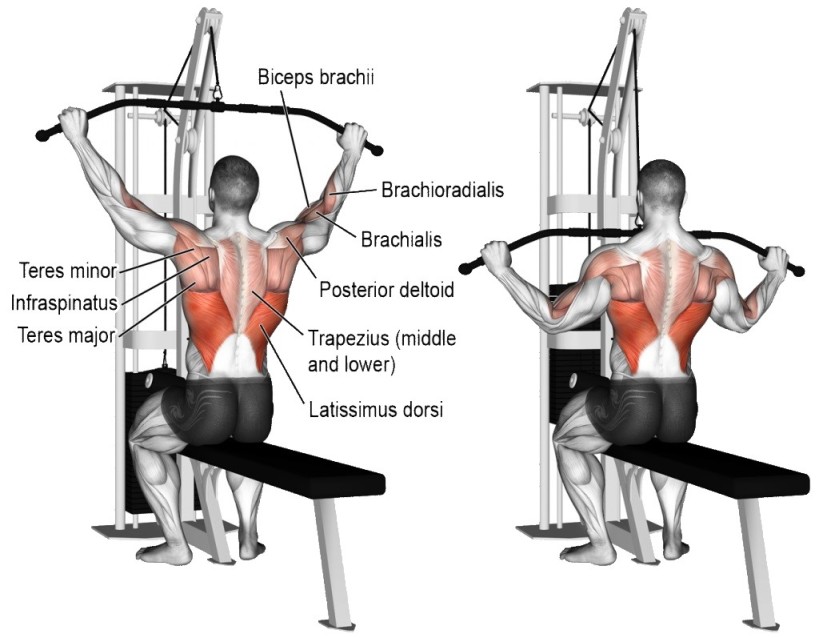
1. Primary Muscles Worked During Lat Pulldown
- Latissimus Dorsi are large, flat muscles that cover the middle and lower back. The lats help the shoulder joint move up and down, so they are very active during a lat pulldown.
2. Lat Pulldown Secondary Muscles Worked
- Rhomboids aid in adduction and retraction of the scapulae. They assist the lats during pulldown.
- The trapezius supports scapular retraction and elevation. The mid and lower traps are engaged during pulldown.
- Posterior Deltoid (rear deltoid muscle), located on the backside of the shoulders.
- Levator Scapulae helps elevate the scapula and is engaged when pulling the bar.
- Teres Major is located near the lats and aids in shoulder adduction and medial rotation.
- Infraspinatus and Teres Minor are part of the rotator cuff muscles and are engaged for shoulder stabilization.
3. Stabilizing Muscles Worked Pulldown
- Biceps Brachii works as a stabilizer and is involved in the elbow flexion part of the exercise.
- The brachialis is located underneath the biceps, and this muscle also aids in elbow flexion.
- Brachioradialis, muscle of the forearm that assists in flexing the elbow.
- The Serratus Anterior helps with the movement and stability of the scapula, supporting it during the downward pull.
- Core Muscles: While not targeted, your core muscles engage to stabilize your torso during the exercise.
How To Do Lat Pulldown
- Adjust the thigh pads and select a weight on the lat pulldown machine that works for you.
- Sit down and place your legs under the pads to secure your knees.
- Grip the bar using a wide overhand grip, slightly wider than shoulder width. Arms should be fully extended overhead.
- Keep your back straight while sitting up straight and slightly lean back.
- Pull the bar downwards towards your upper chest. To perform this action, focus on using your lats, not your biceps.
- Your elbows should point downwards and a bit to the rear as you pull the bar.
- Pull the bar down until it almost touches your upper chest. Don’t swing the torso.
- Focus on squeezing your lats at the bottom of the movement for maximum muscle engagement.
- Release the bar back to the starting position with your arms extended and feel the stretch in your lats.
- Repeat for the desired reps without letting the shoulders or arms take over.
Lat Pulldown Form and Tips
- A slight backward lean is normal, but avoid excessively leaning back, as it can disengage the latissimus dorsi and put unnecessary strain on your lower back.
- Maintain an upright posture, leaning slightly back, just enough to prevent the bar from hitting your face.
- Make sure you fully extend your arms at the starting position and pull the bar down at the upper chest level. Additionally, focus on squeezing the shoulder blades together at the bottom of the movement.
- Use a pronated grip (palms facing away) slightly wider than shoulder-width. Gripping the bar too wide or too narrow can reduce the exercise’s effectiveness and potentially strain your wrists and shoulders.
- Avoid extending the elbows too far or dragging them too far back, as this can reduce lat engagement and strain the shoulders.
- Before pulling the bar, slightly retract your shoulder blades to engage the upper back.
- Avoid lifting weights that are too heavy, as this can compromise your form and increase the risk of injury. Choose a weight that you can do the desired number of reps with good form. Then, gradually increase the weight.
- Use controlled, steady movement while pulling the bar down and releasing it back up.
- Avoid doing a lat pulldown behind the back because it can put extra stress on the shoulder joints and make the exercise less effective at targeting the lats. (Note: Some people can perform behind-the-neck pulldowns without issues, but it’s generally not recommended for most due to the risk of shoulder strain.)
- Occasionally vary your grip (e.g., using a neutral or supinated grip) or use attachments to target different parts of your back and prevent plateaus
Hand And Grip Position For Lat Pulldown Variations
The hand and grip position are important when performing the lat pulldown exercise. The standard position is a wide grip with an overhand. However, other positions and grips are possible, and each variation targets different muscles in the back.
We will discuss how to do the lat pulldown exercise with different hand and grip positions and how they activate the muscles.
Lat Pulldown Grip Position
Here are the three most common grip positions for lat pulldowns:
1. Overhand Grip
The overhand grip is the most popular hand placement for lat pulldown. When you hold the bar, it is facing away from you.
During lat pulldown, using an overhand grip powerfully targets the lats while also engaging the biceps as a secondary muscle group.
This grip allows you to pull the greatest load and is ideal for building back size.
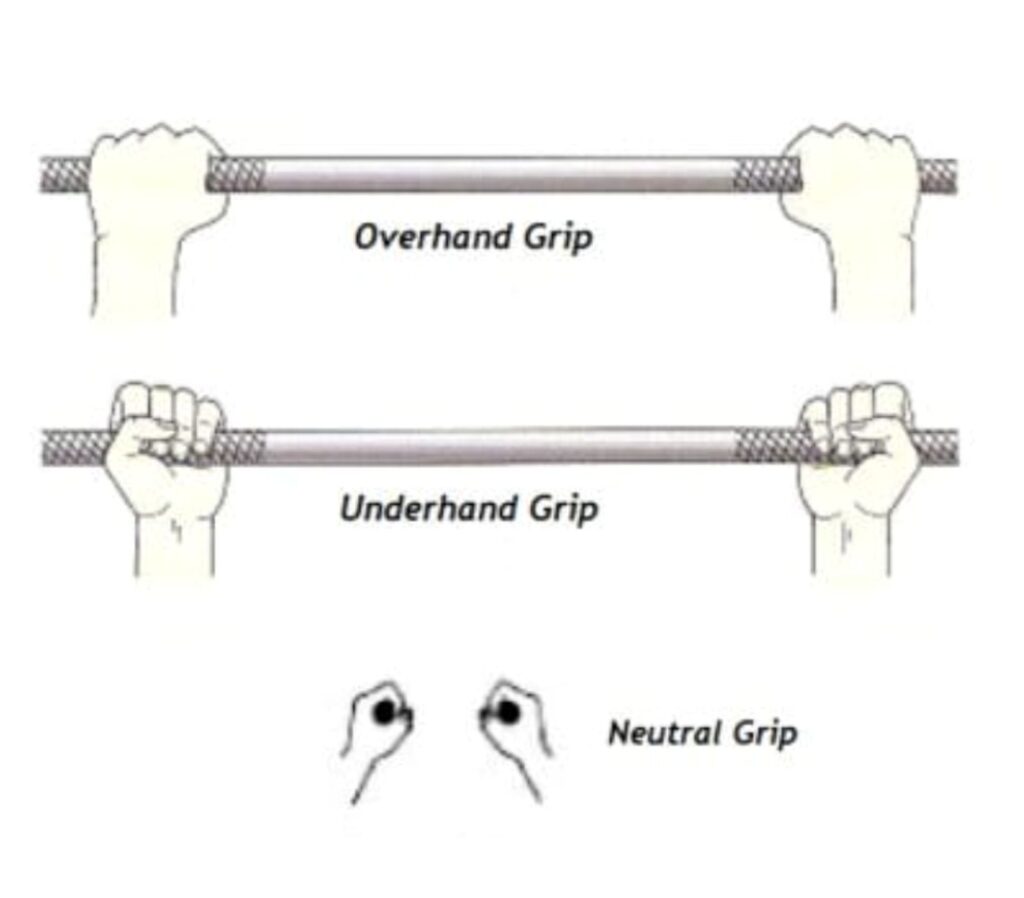
2. Underhand Grip (Reverse Grip)
An underhand grip puts your hands in a supinated position, with the palms facing back towards you. This position emphasizes the lower lats and middle traps, rhomboids of the upper back, while also engaging the biceps.
The underhand grip is great for developing a well-rounded lat. It provides more lat contraction at the bottom of the movement.
3. Neutral Grip
With a neutral grip, your palms face each other. This grip hits the lats similarly to the overhand variation but spreads the tension more evenly across the biceps as well.
The neutral grip can be easier on the wrists while decreasing stress on the elbow joints.
Lat Pulldown Grip Width
The width of your grip on the lat pulldown bar impacts which muscles are targeted and the exercise’s range of motion. Choosing the right size grip width helps stretch the lats to their full potential and makes them work harder.
1. Narrow Grip
A narrow grip focuses more on the lats and middle and lower traps and provides a good range of motion for the biceps. Use a grip that is closer than shoulder width.
2. Wide Grip
A wide grip enhances the emphasis on the rhomboids and rear deltoids. A grip that is significantly wider than shoulder-width. This will naturally force you into an overhand grip, causing your elbows to flare out.
Know More: 20 Best Cable Back Exercises For Wider And Strong Back
Benefits Of Lat Pulldown
The lat pulldown is a gym staple for building a muscular, V-shaped upper back. It offers many benefits, including building strength and mass.
1. Builds a Stronger Back
The lat pulldown exercise is highly effective for developing a strong, muscular back. Building strength in the lats not only provides the pulling power required in daily life and sports, but also promotes a stable, upright posture.
2. Improves Posture
Proper posture is vital for health and aesthetic appeal. Maintaining good posture prevents injury and wear-and-tear damage to the vertebrae and spine over time.
The lat pulldown exercise enhances posture by training the muscles involved in scapular depression and retraction.
As you perform lat pulldowns, scapular depressors and retractors like the lower trapezius and rhomboids are activated. This strengthens the ability to hold the shoulders down and back for better posture.
3. Builds Muscle Mass
Many bodybuilders want a wide, V-shaped back. This aesthetic look is achieved by increasing the size and thickness of the latissimus dorsi, the largest back muscle. Regular lat pulldown exercises can help the lats grow bigger and stronger.
4. Prevents back pain
The back contains a complex arrangement of muscles, tendons, and ligaments that support the vulnerable spine. Weak spinal extensors or an unstable lower back commonly causes back pain. Strengthening the lats through lat pulldowns helps stabilize the lower back and may reduce back pain.
5. It Is a versatile exercise
Lat pulldown can be done with various grips, allowing you to target different muscle groups.
The wide grip lat pulldown targets the lats more, while the narrow grip lat pulldown targets the biceps more.
The reverse grip lat pulldown targets the biceps and forearms more than other variations. The neutral grip lat pulldown targets the middle back muscles.
6. Beginner-Friendly Exercise
The lat pulldown is an ideal beginner exercise due to its simple movement pattern and ease of learning.
Unlike technical lifts that require careful technique, the pulldown uses a natural pulling motion. After just a few practice sets, most trainees can coordinate drawing the bar down to the torso.
You can also change the weight to fit your ability level. With a little practice, new lifters can quickly self-correct and master proper pulldown form.
7. Improves Grip Strength
Lat pulldowns are an excellent exercise for improving grip strength. The pulling exercise requires you to hold on to the wide bar while you control moderate to heavy loads. This keeps the hands and forearms busy throughout the set to build strong gripping power.

Lat Pulldown Variations
There are many ways to target various muscles in the back with the lat pulldown exercise. Several popular variations can add variety to your workout routine.
1. Wide Grip Lat Pulldown
The wide grip lat pulldown uses a grip wider than shoulder-width to target the outer portion of your latissimus dorsi.
The wider grip shifts some of the workload to the upper back muscles, including the rhomboids, teres major, and rear deltoids. This happens because the flared elbow position recruits these muscles more effectively.
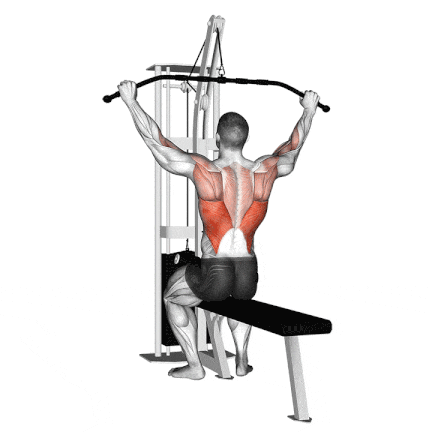
How To Do
- Grab the bar with an overhand grip, with your hands wider than shoulder-width apart.
- Lean back slightly so your torso.
- Pull the bar down towards your chest, keeping your elbows close to your sides.
- Pause for a second at the bottom of the movement, then slowly release the bar back to the starting position.
2. Close Grip Lat Pulldown
The Close Grip Lat Pulldown is a variation of the traditional Lat Pulldown exercise that targets the latissimus dorsi (lats) but places more emphasis on the middle and lower portions of the trapezius, as well as the biceps.
It’s performed using a narrow or close-grip handle attachment.
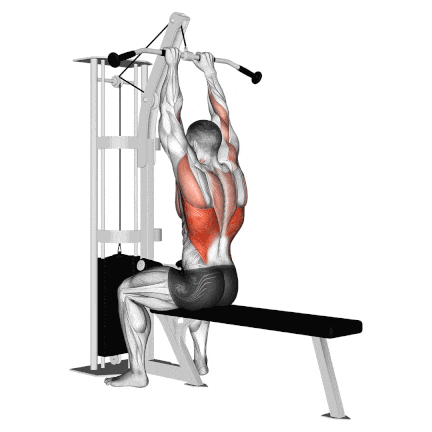
How To Do
- Use a grip just inside shoulder-width with palms facing away.
- Pull the bar straight down to your upper chest.
- Squeeze your lats hard at the bottom contracted position.
- Slowly return the bar back to the starting position with control.
- Keep your elbows tucked close to your sides throughout the movement.
3. Reverse Grip Lat Pulldown
The Reverse Grip Lat Pulldown is performed with an underhand grip (palms facing towards you). Compared to other variations, the reverse grip emphasizes the lower lats more.
The underhand grip results in higher bicep activation due to the movement’s natural biomechanics.
Use can use both wide and narrow grip to perform the reverse grip lat pulldown.
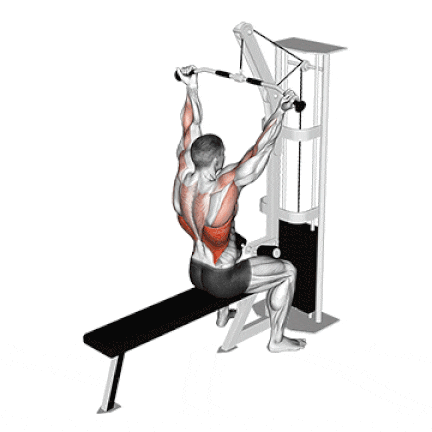
How To Do
- Grasp the bar with a reverse grip with an underhand, knuckles-up grip.
- Pull the bar down until it’s approximately level with the chin.
- Squeeze the shoulder blades together at the bottom of the movement.
- Slowly return the bar back to the starting position with control.
4. Single-Arm Lat Pulldown
If you have one lat that’s stronger or more developed than the other, single-arm lat pulldowns can help even things out.
It is a unilateral variation of the classic lat pulldown that targets your lats and allows you to focus on each side individually. The unilateral movement increases the range of motion and allows for increased lat concentration.
Since you are resisting rotation and keeping balance while doing it, your core muscles have to work harder to keep your body stable.
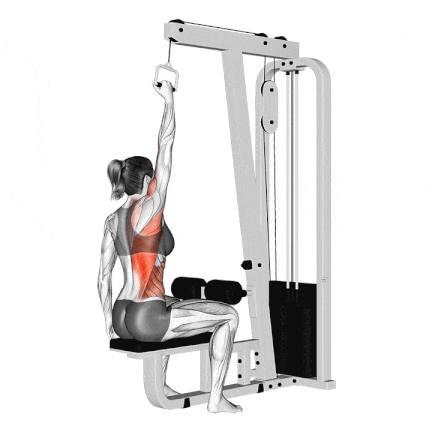
How to Do
- Grab the handle in one hand using an overhand grip.
- Pull the handle down towards your side until it touches the upper chest.
- Squeeze the working lat hard and pause briefly.
- Slowly return the handle to the starting position with control.
- Complete all reps for one side before switching.
5. V-Bar Lat Pulldown
The V-bar Lat Pulldown is a variation of the Lat Pulldown exercise that targets the back muscles. In a standard lat pulldown, you use a wide grip on a straight horizontal bar.
The V-shaped bar attachment allows you to use a close, neutral grip. While it primarily targets the back, you will also notice a fair amount of bicep and middle back activation.
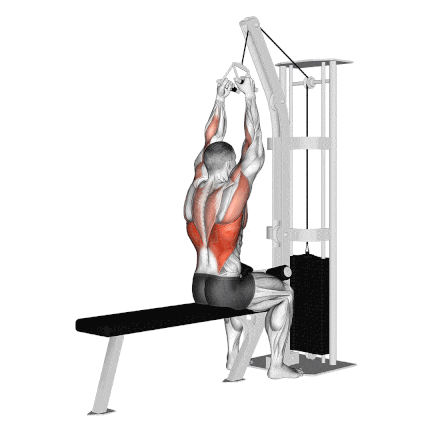
How To Do
- Attach a V handle to the high pulley of a lat-pulldown station.
- Grab the handles with your palms facing each other.
- Keep your upper back straight, pull the V handle down, and bring it up to the chest.
- As you pull down, squeeze your shoulder blades together and feel your back muscles contracting.
- Now, release the bar with controlled motion and stretch your lats as much as possible.
6. Behind-the-Neck Lat Pulldown
To perform the Behind-the-Neck lat Pulldown, you must pull the bar down behind your head rather than in front of your chest.
Though this variation can offer some unique benefits, it’s important to note that it may not be suitable for everyone due to the range of motion it demands from the shoulder joint.
It can force the neck and shoulders into potentially risky positions, especially when the head tilts forward during the movement. This misalignment with the spine can lead to increased stress on the neck joints.
(Note: This variation is not recommended for people with shoulder issues.)
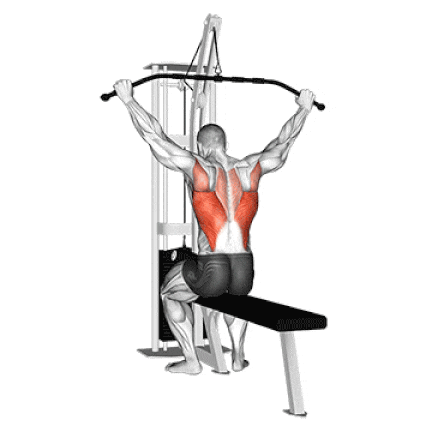
How to Do
- Sit under the machine, securing your thighs under the knee pads.
- Grab the bar with an overhand grip. Your hands should be wider than shoulder-width apart.
- Slowly extend your arms back to the starting position
- Pull the bar down behind the neck until it lightly touches.
- Focus on squeezing the lats at the bottom.
- Return slowly to the starting position.
7 Best Lat Pulldown Variations for a Wider, Stronger Back
FAQs
Is lat pulldown good for the biceps?
Yes, lat pulldowns can be good for the biceps, but it depends on your grip. A close-grip lat pulldown will target the biceps more than a wide-grip lat pulldown.
While the primary muscle worked during the lat pulldown is the latissimus dorsi, the biceps are also activated.
Is lat pulldown a compound exercise?
Yes, lat pulldown is a compound exercise. It works the latissimus dorsi (lats), the largest muscle in the back, biceps, rhomboids, and trapezius. It is also considered vital for developing back strength and increasing overall pulling strength.
Should you lean back on the lat pulldown?
Yes, you should lean back slightly on the lat pulldown. Leaning back helps engage the lats more and prevents you from using too much momentum to pull the weight down.
If you lean back too far, you can put stress on your shoulders and neck. However, if you don’t lean back at all, you won’t be able to engage the lats as much.
Does lat pulldown work shoulders
Yes, the lat pulldown exercise works the shoulders, but to a lesser extent than the back muscles. The primary muscle worked during the lat pulldown is the latissimus dorsi, but the exercise also targets the teres major, rhomboids, and rear deltoids.
Conclusion
The Lat Pulldown is a versatile and highly effective exercise for targeting the muscles in your back, particularly the latissimus dorsi.
Multiple variations range from the Classic Lat Pulldown to the Single-Arm and Reverse Grip versions. Each variation offers a unique set of benefits.
It’s important to note that while these exercises target the primary muscle, the latissimus dorsi, they also engage secondary muscles, such as the biceps, rhomboids, and trapezius.
Whatever variation you choose, ensure proper form and technique to avoid common mistakes and reduce the risk of injury.
References
- Andersen, V., Fimland, M. S., Wiik, E., Skoglund, A., & Saeterbakken, A. H. (2014). Effects of grip width on muscle strength and activation in the lat pull-down. Journal of Strength and Conditioning Research, 28(4), 1135-1142. doi:10.1097/JSC.0000000000000232
- Lusk, S. J., Hale, B. D., & Russell, D. M. (2010). Grip width and forearm orientation effects on muscle activity during the lat pull-down. Journal of Strength and Conditioning Research, 24(7), 1895-1900.
- Lehman, G. J., Buchan, D. D., Lundy, A., Myers, N., & Nalborczyk, A. (2004). Variations in muscle activation levels during traditional latissimus dorsi weight training exercises: An experimental study. Journal of Strength and Conditioning Research, 18(3), 500-506.
- Snyder, B., & Leech, J. (2009). Voluntary Increase in Latissimus Dorsi Muscle Activity During the Lat Pull-Down Following Expert Instruction. Journal of Strength and Conditioning Research, 23(8), 2204-2209. doi:10.1519/JSC.0b013e3181bb7213
- Sperandei, S., Barros, M., Silveira-Júnior, P., & Oliveira, C. (2009). Electromyographic Analysis of Three Different Types of Lat Pull-Down. Journal of Strength and Conditioning Research, 23(7), 2033-2038. doi:10.1519/JSC.0b013e3181b8d30a

Manish is a NASM-certified fitness and nutrition coach with over 10 years of experience in weight lifting and fat loss fitness coaching. He specializes in gym-based training and has a lot of knowledge about exercise, lifting technique, biomechanics, and more.
Through “Fit Life Regime,” he generously shares the insights he’s gained over a decade in the field. His goal is to equip others with the knowledge to start their own fitness journey.
